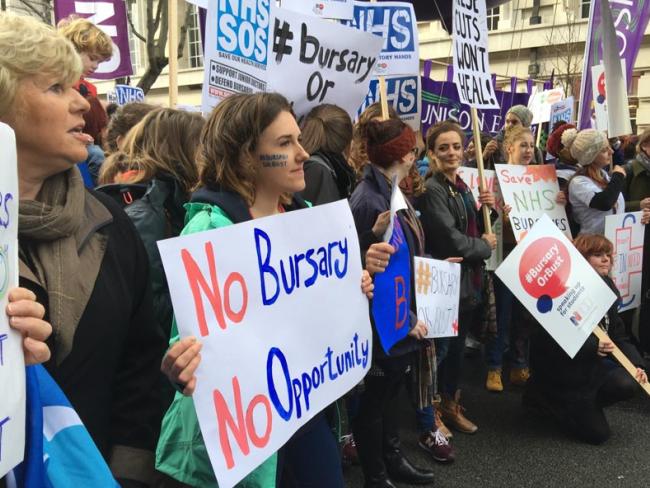2 February 2016

Nursing students marching in London on 9 January. Photo Workers.
The only good thing to have arisen from chancellor George Osborne’s plan to institutionalise debt for student nurses and other health students is a debate about what is wrong with the current system and how workers in the NHS would like to do things better.
The current system of education for health students is already problematic. There is a significant drop out rate from the courses with a national dropout average rate of about 25 per cent for student nurses – and this masks much higher rates at some institutions where fewer than half the students complete their studies and enter the register.
Demands
Explanations for the high dropout rate include the low level of the existing bursary but also other reasons including an inability to cope with the demands of 12-hour shifts and academic work. But within the current system two groups of students are more likely to stay the course. One group is students who have an existing degree and study nursing as a postgraduate option – and they will be particularly deterred by Osborne’s proposal.
The other group with a low dropout rate are those health care assistants or nursing auxiliaries who managed to get seconded to undertake the programme for registration. In terms of staying the course, these students have obvious advantages. They already know about the realities of bedside nursing, they already know about shift work and as they are seconded, they receive a health care assistant salary rather than a bursary.
The other strength of the process is that these candidates reached the course following nomination by a ward manager who had already assessed their in-work capability and have a job to return to on completion. A win-win situation for the student, the NHS and patients.
‘Grow your own’
In recent years the amount of the educational pot allocated to the secondment of health care assistants has been eroded which makes no sense when this “grow your own” policy has been shown to be successful. Health care assistants currently make up 40 per cent of the NHS workforce and provide about 60 per cent of the direct patient care under supervision. But this huge group of staff only receive 5 per cent of national training budgets and any secondments must be paid for from that 5 per cent!
‘All that is on offer is personal debt for students and the creation of a new breed of “nurse” called a nursing associate’
Although the NHS talks loudly about “evidence based care” the proposals to impose loans on student nurses have not been subject to any workforce modelling, risk assessment or proper debate. Clearly a different model of preparation for registered nurses could include a huge expansion of the secondments and in doing so, provide a career structure for what is estimated to be 1.3 million people working as health care assistants working across health and social care settings.
Yet all that is on offer is personal debt for students and the creation of a new breed of “nurse” called a nursing associate.
‘American’ associates
The role of “nursing associate” (an American title) was part and parcel of the same Department of Health statement as the cuts to student funding but it has not received the same attention. Superficially the “nursing associate” offers a route to progress to registered nurse similar to the secondment route mentioned above, which is why the health trade unions have tentatively welcomed the proposal. But the devil will be in the detail.
Unfortunately the Department of Health’s proposal talks about this being via an “apprenticeship route” – and would presumably entail “apprentice wages”, in other words, a reduction in the current already low wage for health care assistants! So stand by for the consultation on new funding arrangements for health care students and on the role of the nursing associate which is due in February 2016.
